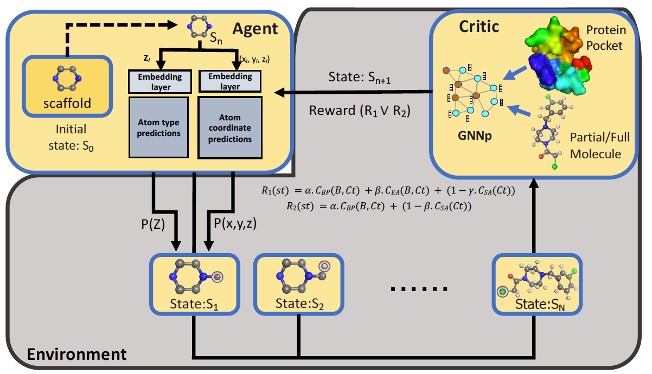Technology Overview
This technology leverages an innovative 3D scaffold framework combined with reinforcement learning to design novel drug candidates. By optimizing molecular structures, atom by atom, it addresses the limitations of current drug discovery methods. This approach accelerates the discovery process and enhances the precision of drug-target interactions, making it highly relevant to the pharmaceutical industry.
The pharmaceutical industry faces significant challenges with traditional drug discovery methods, often suffering from slow, iterative design-test cycles and requiring extensive expertise. These inefficiencies lead to average drug development timelines of over a decade, causing delays and high costs.
This technology developed at Pacific Northwest National Laboratory overcomes these barriers by using a novel, deep learning model named 3D-Scaffold. This model efficiently generates 3D coordinates of molecules starting from a given scaffold while preserving its structure. Utilizing 5,000 molecules from the Food and Drug Administration and Enamine databases, this technology generated training datasets consisting of six unique scaffolds, yielding a 3D scaffold framework that places atoms one at a time in 3D space with high fidelity. The framework achieves atomic-level precision in generating drug-like molecules, which are evaluated through binding affinity and interaction forces scores.
Scientists at Pacific Northwest National Laboratory have engineered this technology to iteratively add atoms to a molecule under construction, guided by a reward function. This approach optimally tunes the molecular structure for high-binding affinity and synthetic accessibility, thus addressing the inefficiencies and inaccuracies in current drug design techniques. This innovation reduces the time required for developing potent pharmaceuticals, significantly impacting the industry's cost efficiency and effectiveness.
APPLICABILITY
This technology can be used in the pharmaceutical industry by drug developers and researchers to design new drug candidates. Potential users include pharmaceutical companies, biotech firms, and research institutions focused on drug discovery.
Advantages
- Accelerates drug discovery timelines by optimizing molecular generation with artificial intelligence
- Enhances accuracy of drug-target interactions, leading to higher efficacy
- Reduces costs associated with traditional drug discovery methods
- Utilizes a robust dataset from FDA and Enamine to ensure drug-likeness and potency
For more information, please contact: commercialization@pnnl.gov.
